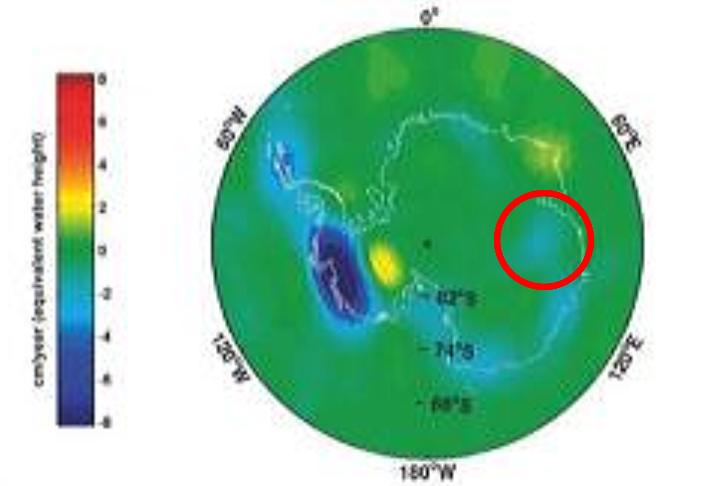Last November, the headlines read “NASA Satellites Detect Unexpected Ice Loss in East Antarctica”
Remarkably, they claimed that ice was disappearing at a rapid rate from an area of East Antarctica (500 km from the coast) – where the temperature never gets anywhere close to the melting point.
In any other field of science, this would have been recognized immediately as – let’s say “ignorant.” Incredibly ignorant.
But not in the world of climate science. It seemed that every AGW proponent from Hansen on down bought into it – even though it obviously wasn’t correct.
It took me about 10 seconds to realize what they had likely done wrong – they didn’t account properly for changes in the elevation of the ground underneath the ice. And finally in September, 2010 they admitted their mistake.
As researcher Bert Vermeersen, a professor at Delft University of Technology in the Netherlands, told the AFP, the earlier estimates failed to account for glacial isostatic adjustment—the rebounding of the Earth’s crust after the end of the last Ice Age:
If they can’t get the most fundamental rules of science straight, how can we expect them to get the right answer to complex problems?
Ice does not melt at -25C.
[youtube=http://www.youtube.com/watch?v=IzjbFYy6NPo]





There have been visual observations (from small aircraft) that countered the satellite observations from day one.
This is what happen when the science is turned into a political weapon.
Steve says: “Remarkably, they claimed that ice was disappearing at a rapid rate from an area of East Antarctica (500 km from the coast) – where the temperature never gets anywhere close to the melting point.”
Crap. It took me all of 10 seconds to realise your mistake Steve.
East Antarctica may average below zero for the year, but there are times when the temperature is hot enough for ice to melt.
Mawson Station – East Antarctica
http://www.antarctica.gov.au/webcams/mawson
Temperature Data for Jan 2010
http://www.bom.gov.au/climate/dwo/201001/html/IDCJDW9202.201001.shtml
The Temp at 3pm was NEVER below zero. The highest was 4.3 and the mean was 2.5.
Look at the maps. The area in question is -25C in the summer. This is 500 km from the coast at high altitude. It took about one nanosecond to see your error.
Sublimation occurs at temperatures below zero. It’s common for snow to disappear in arctic regions without there being any ‘melting’.
Where’d you get your temp data from Steve?
Never mind, I found it on wikipedia and I think I know why you didn’t reference it – trying to hide something again Steve?
http://en.wikipedia.org/wiki/File:Antarctic_surface_temperature.png and they say “40 year reanalyses, for the period 1979-2001. There remain uncertainties in the values.”, they also say “Summer: DJF (dec-jan-feb).”
So this is an average summer temp for 22 year period that ended 9 years ago. So where’s the max temp in Jan for the region? That would tell us if there can be direct melt there.
But there’s another problem, as bbttxu says, there are more ways to lose ice than directly through melting.
Using your own source of info, wiki … http://en.wikipedia.org/wiki/Ablation#Glaciology
You’re being short-sighted by thinking that only temperature alone, in the location of the mass decrease, could be responsible for a loss of mass.
Reading up on glaciology I see that glaciers are thought to be restricted in movement by the ice that is lower and nearer to the water.
If you look at the observed melting ( http://en.wikipedia.org/wiki/File:Antarctic_Ice_Melt-First_Year.jpg ), there is a large amount happening nearer the ocean. Any glacier depending on that ice would start moving faster than before.
You could get movement of the glacier inland which results there being less mass inland, even though there is no melt directly there. Read More
So we got:
– Ice going missing between 2002-2009, but you get average temp data for 1979-2001.
– Steve neglects any uncertainties in the temp data.
– No maximum temps recorded so we don’t actually know for sure if it did remain below freezing, (even though it’s for the wrong years).
– You neglect glacier movement altogether including the possibility that ice melted at lower levels speeds glacier movement.
– You ignore sublimation.
But oh no. Steve still thinks it can’t disappear because of a three month average temp obtained for a completely different period.
I guess you’re neither a glaciologist nor a climatologist, but more of a confusedologist?
Maybe next time spend more than 10 seconds considering before posting. 😉
“Incredibly ignorant” – oh the irony.
Antarctic temperatures have cooled over the last 30 years. There is no dispute that temperatures in the interior of Antarctica are incredibly cold all year round.
The temperature in Vostok is -88F on this fine spring day.
http://www.wunderground.com/cgi-bin/findweather/getForecast?query=-78.44999695,106.87000275
Try doing some reading instead of firing off ridiculous comments.
Steve says “Antarctic temperatures have cooled over the last 30 years. There is no dispute that temperatures in the interior of Antarctica are incredibly cold all year round. ”
And yet you only post average temperatures. Where’s the reference to the paper that backs up your statement?
Nor have you shown why melting ice nearer the edge cannot affect glacier flow like the experts tell us it does. That could affect inland mass too.
Steve says “The temperature in Vostok is -88F on this fine spring day.”
But we’re not talking about Vostok. Try to concentrate very hard.
Steve says “Try doing some reading instead of firing off ridiculous comments.”
Right back at ya!
All that sublimation made the ice 2 miles thick.
That’s your theory?
Beautiful use of Homer! I submit that you should use it each time the warmistas have one of their many “D’oh” moments. Maybe you can add a “D’oh” Homer for each moment to keep track!
You could put it right next to your name! 🙂
The Temp at 3pm was NEVER below zero. The highest was 4.3 and the mean was 2.5.
You didn’t say but if mean is 2.5 F then ice wouldn’t melt. Needs 32 F. Be more specific please.
°C was stated in the table of temps that I liked to.
http://www.bom.gov.au/climate/dwo/201001/html/IDCJDW9202.201001.shtml
Brendon says:
October 12, 2010 at 6:05 am
Steve says “The temperature in Vostok is -88F on this fine spring day.”
But we’re not talking about Vostok. Try to concentrate very hard.
Brendan. Vostok means east. i am pretty sure it is located in East Antarctica.
and i am pretty sure steve’s article is about east antarctica ;: